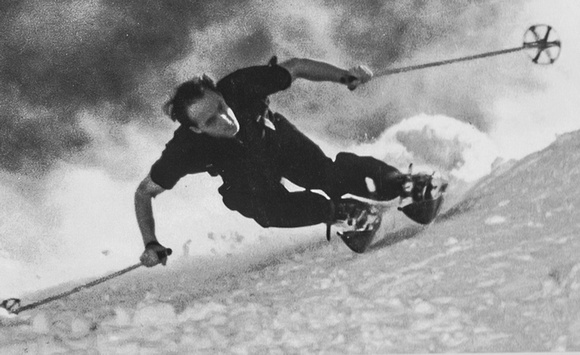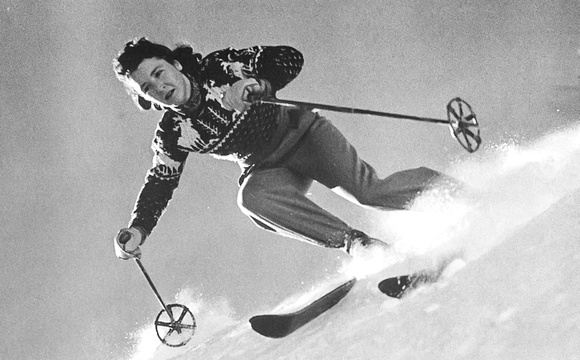Ski Racing, Again, Part 9; March 2018
Peter Lunn wrote "High-Speed Skiing," first published in 1933. It focused on skiing fast, especially in downhills and slaloms. Lunn was the son of Sir Arnold Lunn, inventor of the modern (1922 on) slalom and one of the pioneers in alpine race organization and innovation. Peter raced for Britain in the 1930s, captained its teams in 1934-36, and was captain of its team at the 1936 Olympics.
His book had much to say about technique, tactics, and equipment. Much of it sounds quaint now, but it was an English-language revelation at the time, trying to address comprehensively every aspect of skiing fast.
He had firm comments about stance. Shoulders were hunched and far forward, feet were together, one knee was tucked tightly behind the other for stability (to avoid the dreaded "speed wobble" - which is "an uncontrollable slithering of the ski-points"), hands were apart for balance. He had comments about skiing "an unknown country," where avoiding unseen diagonal guys wires for telegraph poles was advised by a friend who "was nearly killed by disregarding" that rule. And about physical training, since the "majority of British racers" were inclined to disregard the importance of training, especially given the difficulty of avoiding the bar and getting enough sleep, and the need to calm with a cigarette nerves "frayed by the strain and excitement of races." He recommended cutting down smoking gradually two or three months before a race, and certainly smoking no more than five cigarettes a day.
He urged studying downhill courses carefully, but recommended learning natural landmarks, not artificially marking blind bumps, since someone might move the marks. (One racer marked a blind bump with his climbing skins; a friend saw them, didn't know who owned them, but realized they were very close to the racer's intended line, and moved them away; in the race, the competitor took his line from his now-moved skins, jumped "twenty feet through the air and landed in a clump of bushes.") Lunn recommended running the course at race speeds several days before the race, and not skiing the day before race day, but also not "going down to the valley and spending the day among the amusements of a large town."
On race day, he suggested being "uncomfortably hot" in the start, avoiding all stimulants, but if unable, then taking only brandy. Given different delayed reactions and the brief window of stimulation, he thought that for those inclined to brandy, "it is advisable to experiment considerably with brandy before taking it in an important race." Since he was a member of the British team for five years, and captain for three, Lunn's advice implies that he had ample opportunity to observe racers, some possibly British, who had resorted to brandy, cigarettes, and down-valley amusements, to their racing disadvantage. One can also appreciate the diligence of the racers who followed his advice and, on non-race days only, of course, experimented "considerably" with brandy to determine the appropriate dosage and when to take it on race day.
To return to stance. Here are the drawings Lunn used to illustrate the stance for "straight running." The drawings are accurate for Lunn's advice to a slow-moving skier on level snow. But they don't illustrate what the best racers of that period were really doing.
The extreme forward pressure needed in those days was created in Lunn's drawing by moving the upper torso far forward; the knees were bent, but not extremely so.
 Lunn Straight Running Diagram
Lunn Straight Running Diagram
In comparison, Dick Durrance, the premier American skier in those days, generated extreme forward pressure with very bent knees. The uphill knee was close to his chest, and any modern racer would see similarities to modern skiing. And the knees were not tucked or locked together; both skis and knees were separated equally and edged equally, especially in this high-edge-angle turn on a steep hill. This was not unique to Durrance; top European racers were doing similar things. And indeed, probably the British racers and Lunn himself in those days were actually practicing equivalent technique. But probably not with Dick Durrance's panache.
 Lunn Durrance_-3
Lunn Durrance_-3
Dick Durrance wasn't technically unique in America, either, despite his superior speed and dynamic stance. Here is Miggs Durrance, Dick's wife, in 1941. Her inside knee is high and well separated from the outside knee. Her skis are edged equally with ample forward pressure.
 Lunn Miggs-3
Lunn Miggs-3
This was good skiing. The Durrances could have easily adapted to modern racing technique, courses, and gear.
Comments


After a lifetime of mainly expressing myself with words, my postings here will mainly rely on images. They will speak for themselves to some extent, but I'll usually add a few comments of explanation. I've taken photographs for decades, since the 1950's, inspired in part by my father's photographic skill. Four years of photo assignments and quality darkroom time eventually gave way to decades of casual and family picture-taking. I re-immersed myself when I left film and turned to digital.